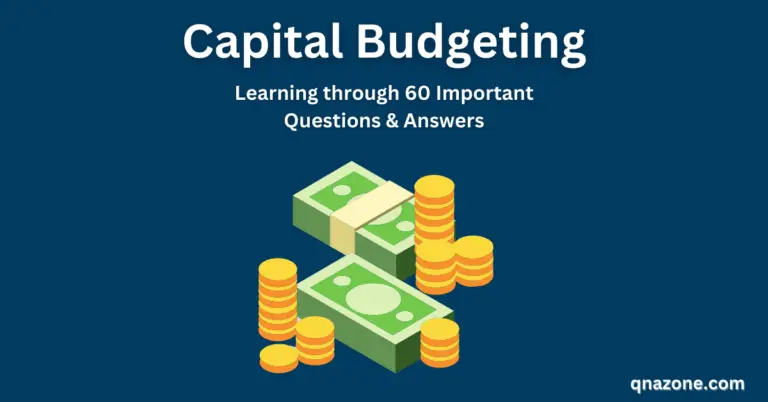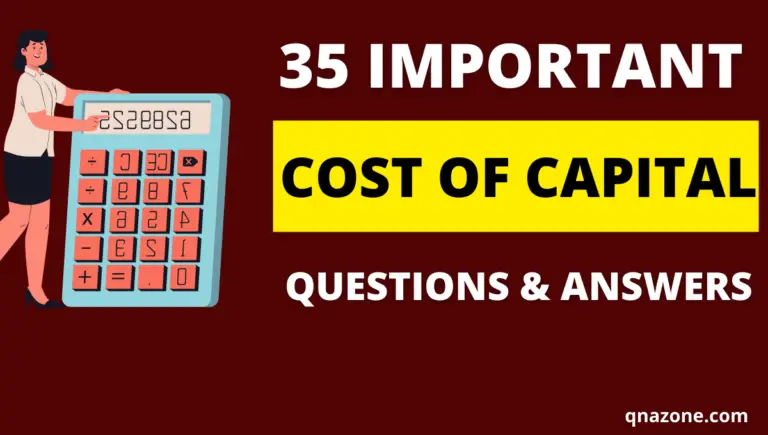30 Important Time Value of Money Questions and Answers [Notes with PDF]
The second chapter of our finance learning course is “Time Value of Money”. In this article, we’ll learn the 30 most important time value of money questions and their answers.
It will help you understand the important time value of money terms and their explanations quickly.
You can read the first chapter of our finance learning course here if you missed it.
By reading this post, you may quickly prepare for finance courses and for any competitive tests such as school and college exams, vivas, job interviews, and so on.
So let get started…
Time Value of Money Questions and Answers:
The 30 important time value of money questions and answers are as follows:
Question 01: What is the Time Value of Money?
Answer: In general, the concept of the time value of money refers to the idea that the value of money received today is greater than the value of money received a few days later or that the value of money received in the future is less than the value of money received now.
From a financial standpoint, the value of money changes with time, so a $100 now and a $100 four years later is not the same. A hundred dollars of that time is more valuable. It’s a concept known as the time value of money.
Question 02: What is the Importance of Time Value of Money?
Answer: The top five importance of time value of money is as follows:
- Understanding the time value of money is important when dealing with future uncertainties. Because the firm is unsure of its future cash receipts, it prioritizes current cash receipts.
- Businesses must compare the current project cost and the expected income or money inflow from investment to assess a long-term project.
- We all know that the present and future values of money are not the same. We can’t make long-term decisions without converting the project’s expected income into a present value.
- If money is invested in one project, it must be foregone to invest in another. It’s known as “Opportunity Cost” in finance. An organization uses the “Time Value of Money” equations to calculate this opportunity cost.
- In today’s world, inflation is common. Inflation reduces the purchasing power of money over time. There is a distinction between today’s $1 and tomorrow’s $1. As a result of the inflation, people are interested in obtaining current money.
Question 03: What is a Timeline?
Answer: When it comes to the time value of money, the timeline is very important.
The timeline shows the amount of money that is currently deposited, the amount of money that will be available after a certain period in the future, or the amount of money that needs to be deposited each year, every month, or in installments to receive a certain amount of money in the future.
A timeline is a line used to present a list of current and future received and payments.
Question 04: What is Present Value?
Answer: The present value is the current monetary value of a future amount—the amount of money that would have to be invested today at a given interest rate over a specified period to equal the future amount.
People prefer current value to future value because the future is unpredictable. And, as a result of the uncertainty, interest or opportunity costs are incurred.
Question 05: What are the Features of Present Value?
Answer: The top five features of present value are as follows:
- Discounting is a method of calculating present value.
- The value of money decreases according to the present value.
- If the interest rate is higher, the present value will be lower.
- The money received after a longer period will have a lower present value.
- PVIF Present Value Interest Factor) expresses the present value of $1 received after a certain period at a fixed interest rate.
Question 06: How to Calculate the Present Value of Money?
Answer:
- Present value of a lump sum:
If a lump sum is paid or received after a certain period of time in the future, its present value can be determined using the following formula:
PV=FV {1/ (1+i) ^n}
Here,
PV= Present Value
FV=Future Value
I=Interest rate
N= Number of Years
An example will help to explain the situation:
For example, if the interest rate is 10% then what is the present value of $1000 to be received after 5 years.
Let’s use above formula to find out the present value of $1000
PV= 1000 {1/ (1+.10) ^5}
PV= 620
Concept: If $1000 will be received after 5 years then the present value is $620 (approximately). So, if you pay $1000 after 5 years, in lieu of paying now, then according to present value your loss will be ($1000-620) =$380
2. Discounting more than once a year:
In case of compounding more than once in a year, we will find out the present value from the future value through discounting.
Formula:
PV=FV {1/ (1+i) ^nm}
Here,
PV= Present Value
FV=Future Value
I=Interest rate
N= Number of Years
M= Number of Compounding Annually
An example will help to explain the situation:
You want to save some money in a bank with the expectation of receiving $50,000 in 5 years. One bank has proposed a monthly compounding rate of 9.5%. How much money do you need to deposit in the bank today?
Let’s use above formula to find out the deposit value
PV= 50,000 {1/ (1+.095) ^5×12}
PV= $ 31, 152.64
Concept: So, $50, 000 to be received after 5years, $31,046.07 have to be deposited in Bank
3. Present value of unequal cash flow:
Formula:
PV= FV1 (1+i) ^1 + FV2 (1+i) ^2 + FV3 (1+i) ^3 +………..+ FVn (1+i) ^n
An example will help to explain the situation:
If a person gets $1000 at the end of the first year, $2000 at the end of the second year, and $3000 at the end of the third year from any investment, what will be his present value if the interest rate is 10%?
Let’s use above formula to find out the present value
PV= 1000 (1+.10) ^1 + 1000 (1+.10) ^2 +1000 (1+.10) ^3
PV= 4,815.93
Question 07: What is Future Value?
Answer: The amount of money available after a certain period in the future if you deposit a certain amount of money now is known as future value or compound value.
If the number of years is greater, compound interest is calculated on the interest. Future value is also referred to as compound value and marginal value.
The future value of a present amount is calculated by compounding interest over a specified period.
Question 08: What are the Features of Future Value?
Answer: The top six features of future value are as follows:
- The future value is determined by adding interest to the current value.
- The value of money increases according to the future value.
- If the number of compounds increases, the amount of future value will increase.
- If the number of years increases, the amount of value will increase in the future.
- The higher the interest rate, the higher the future value.
- FVIF represents the future value of $1 at a fixed interest rate.
Question 09: How to Calculate Future Value?
Answer:
- Future value of a lump sum:
Formula:
FV = PV (1+i) ^n
Here,
FV = Future Value
PV = Present Value
I = Interest rate
N = Number of Years
An example will help to explain the situation:
For example, what will be the future value at the end of the 5 years of $1,000 paying a 5% rate of interest?
Let’s use the above formula to find out the future value of $1000
FV= 1000 (1+.10) ^5
PV= 1620
Concept: If the interest rate is 10% then today’s $1000 has an equal value to be received of $1,610 after 5 years.
2. More than once a year compounding:
Formula:
FV= PV (1+i/m) ^nm
Here,
FV = Future Value
PV = Present Value
I = Interest rate
N = Number of Years
M= Number of compounding in a year
An example will help to explain the situation:
For example, if you deposit $50,000.00 in Bank at 13.5% monthly compounding then what amount will you get after 10 years.
Let’s use above formula to find out the future value of $50,000
FV= 50,000 (1+.13.5/12) ^5×12
PV= 1, 91,423
Concept: So, today’s $50, 000 and to be received $1, 91,423 after 5 years of the same policy has equal value.
3. Future Value of unequal cash flow:
Formula:
Cash flow at the end of the year
FV= PV (1+i) ^n-1 + PV (1+i) ^n-2 + PV (1+i) ^n-3 +…….. + PV (1+i) ^0
An example will help to explain the situation:
If a person deposits $100 at the end of the first year, $200 at the end of the second year, and $250 at the end of the third year in a bank, what will be his future value if the interest rate is 10%?
Let’s use above formula to find out the future value
FV= 100 (1+.10) ^3-1 + 200 (1+.10) ^3-2 +250 (1+.10) ^3-3
FV= 121+220+250
FV= 591
Cash flow at the beginning of the year
FV= PV (1+i) ^n + PV (1+i) ^n-1 + PV (1+i) ^n-2 +…….. + PV (1+i) ^1
An example will help to explain the situation:
If a person deposits $100 at the beginning of the first year, $200 at the beginning of the second year, and $250 at the beginning of the third year in a bank, what will be his future value if the interest rate is 10%?
Let’s use above formula to find out the future value
FV= 100 (1+.10) ^3 + 200 (1+.10) ^3-1 +250 (1+.10) ^3-2
FV= 133+242+275
FV= 650
Question 10: What is the Difference between Present Value and Future Value?
Answer: The top 3 differences between and future value are as follows:
- The present value is the amount of money that needs to be invested in receiving a certain amount of money in the future. On the other hand, if you deposit a certain amount of money at present, the amount of money available after a certain period in the future is called future value.
- The purpose of present value is to save money at current prices to save a certain amount of money in the future. On the other hand, the main purpose of future value is to deposit a certain amount of money to perform a task.
- The present value concept is called discounting, while the method of determining future value is called compounding.
Question 11: What is an Annuity?
Answer: An annuity is the receipt or payment of a fixed sum of money over a specified period. In other words, an annuity is the flow of an equal amount of money at a specified time.
The time between multiple successive money flows and the amount of money flow must be equal for an annuity to exist. If these conditions are not met, no money flow can be referred to as an annuity.
An annuity is a continuous stream of equal cash flows. This cash flow can include inflows of investment returns or outflows of funds invested to earn a future return.
Question 12: What are the Features of an Annuity?
Answer: The top five features of an annuity are as follows:
- Making the same deposit and receiving the same amount of money.
- The time interval is the same.
- In the case of the current price, if the amount of time is longer, People will deposit a smaller amount of money.
- In the case of future value, if the amount of time is shorter, People will deposit a greater proportion of the money.
- Prices fluctuate over time.
Question 13: What is the Classification of an Annuity?
Answer: An annuity can be of two types. These are as follows:
- Present Value of Annuity:
- Present Value of an Ordinary Annuity
- Present Value of an Annuity Due
- Future Value of Annuity
- Future Value of an Ordinary Annuity
- Future Value of an Annuity Due
Question 14: What is an Ordinary Annuity?
Answer: An ordinary annuity is received or deposited at the end of each year, month, or installment. Ordinary annuities are available in both current and future value.
An ordinary annuity is one in which the cash flow occurs at the end of each year or each period.
An ordinary annuity can be divided into two categories.
- Present value of an ordinary annuity
- Future value of an ordinary annuity
Question 15: What is the Formula for calculating an Ordinary Annuity?
Answer:
For Present Value of Ordinary Annuity:
PVA=A [{1-1/ (1+i) ^n}/i]
Here,
PVA= Present Value of Annuity
A=Annuity
I=Interest Rate
N=Number of Years
For Future Value of Ordinary Annuity:
FVA=A {(1+i) ^n-1/i}
Here,
FVA= Future Value of Annuity
A=Annuity
I=Interest Rate
N=Number of Years
Question 16: What is an Annuity Due?
Answer: An annuity due is a sum of money deposited or received at the beginning of each year, month, or installment.
In the case of an annuity due, a cash flow occurs at the beginning of each period.
If you deposited or received the same amount at the beginning of the year, you must include it here. There are two types of annuities due:
- Present value of an annuity due and
- Future value of an annuity due
Question 17: What is the Formula for Calculating an Ordinary Annuity?
Answer:
For Present value of an annuity due:
PVAD=A [{1-1/ (1+i) ^n}/i] (1+i)
Here,
PVAD= Present Value of Annuity Due
A=Annuity
I=Interest Rate
N=Number of Years
For Future value of an annuity due:
FVAD=A {(1+i) ^n-1/i} (1+i)
Here,
FVAD= Future Value of Annuity Due
A=Annuity
I=Interest Rate
N=Number of Years
Question 18: What is the Key Element in Determining the Time Value of Money?
Answer: The key element in determining the time value of money is the interest rate. The change in the value of money as time changes is called the time value of money.
Depending on the interest rate, the future value or current value of the money is determined.
Question 19: What is the Annual Rate?
Answer: The nominal or stated annual rate is the annual contractual rate of interest charged by a lender or promised by a borrower.
For Example, Jk Trade International has taken a loan of $ 100,000 from HSBC for 5 Years at an interest rate of 12%. Here, the annual rate is 12%
Question 20: What is Effective or True Annual Rate?
Answer: The effective or true annual rate (EAR) is the annual interest rate paid or earned.
Formula for calculating effective or true annual rate:
EAR = (1+i/m) ^m-1
For Example, if the nominal interest rate is 12%, what will be the effective annual rate (EAR)?
EAR= (1+.12/1) ^1-1
=1.12-1
= 0.12
=12%
Question 21: What is the Main Similarities and Differences between Annual Rate and Effective Annual Rate (EAR)?
Answer: The main similarities between the annual rate and effective annual rate (EAR) are nominal and effective interest rates are always equal in annual compounding.
The main difference between the annual rate and the effective annual rate (EAR) is that the effective interest rate increases when the number of compounding increases.
Question 22: What is Simple Interest?
Answer: Simple interest is interest that is charged only on the principal amount of money.
In simple interest, interest is charged on principal money at the same rate every year.
Question 23: How to Calculate Simple Interest?
Answer:
The formula for calculating simple interest is
S.I. = P x I x N
Here,
S.I. = Simple Interest
P= Principal
I= Interest
N= Number of Years
An example will help to explain the situation:
What will be the amount of simple interest if $1000 is deposited in the bank for 3 years at 10% interest per annum?
Let’s use the above formula to find out the Simple Interest
SI= 1000 x.10 x3
SI= 300
Here the simple interest is $300
Question 24: What is Compound Interest?
Answer: Compound interest is the interest computed on the principal and any interest earned that has not been paid or withdrawn.
Compound interest is the addition of interest to the principal sum of a loan or deposit, or in other words, interest on interest. It results from reinvesting interest rather than paying it out, so interest in the next period is earned on the principal sum plus previously accumulated interest.
Question 25: How to Calculate Compound Interest?
Answer: The formula for calculating compound interest is
CI= P (1+i) ^n-P
Here,
CI=Compound Interest
P=Capital
I= Interest Rate
N=Year
An example will help to explain the situation:
What will be the amount of compound interest if $1000 is deposited in the bank for 3 years at 10% interest per annum?
Let’s use the above formula to find out the compound interest
CI= 1000 (1+.10) ^3-1000
CI= 331
Here the compound interest is $331
Question 26: How to Calculate Annual Compound Interest Rate?
Answer: We calculate the annual compound interest rate from the following example:
Harry has taken a loan of $ 10,000 from a bank for 3 years. After 4 years, he has paid a total of $13,310. What is the annual compound interest rate?
Here,
PV=$10,000
FV=$13,310
N=3 Years
I=?
FV=PV (1+i) ^n
13,310 =10,000 (1+i) ^3
=> (1+i) ^3 =13,310/10,000
=> (1+i) ^3 = 1.331
=> I =0.10 = 10%
Annual Compound Interest Rate = 10%
Question 27: What is the Difference between Simple Interest and Compound Interest?
Answer: The top 3 differences between simple interest and compound interest are as follows:
- Simple interest is the interest charged on the principal amount at a fixed rate every year. On the other hand, compound interest is the addition of interest to the principal sum of a loan or deposit, or in other words, interest on interest.
- In the case of simple interest, interest is charged only on the principal amount. On the other hand, compound interest is always charged at a fixed rate on the principal plus interest in compound interest.
- In the case of simple interest, the amount of interest is comparatively less. On the other hand, in the case of compound interest, interest is higher than simple interest.
Question 28: What is Rule 69?
Answer: Rule 69 is a strategy for determining how many years and at what percentage of interest investment will double.
It means that an investor can use this rule to know in what year or at what time and at what percentage of interest he will double his deposit.
The following equation is used in the case of Rule Sixty Nine.
N=.35+ 69/i
Here,
N= Number of Years
I= Interest rate
Question 29: What is Rule 72?
Answer: Rule 72 is a policy by which an investor can determine at what time and at what percentage of interest he will double his investment.
This formula gives an approximate idea of how much time is invested and at what rate it will double. The following equation is used for Rule 72:
N=72/i
Here,
N= Number of Years
I= Interest rate
Question 30: What is Perpetuity?
Answer: If the annuity is for a permanent or indefinite period, it is called a perpetuity. There is no fixed term for perpetuity. The following formula is used to determine the current value of perpetuity:
PV of Perpetuity= A/i
Here,
A= Annuity
I= Interest rate
I hope that by the end of this post, you have a good understanding of the “Time Value of money” chapter. If you have any doubts or questions, don’t hesitate to contact us or leave a comment so that we can respond soon.
You can also read:






Wow the notes are interesting
GOOD SIMPLE EXAMPLES
Great examples ,,,, they’ve helped me understand the concept better